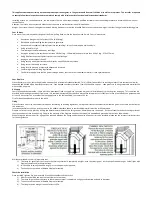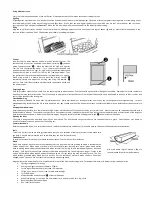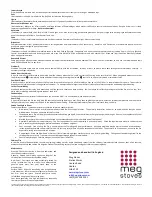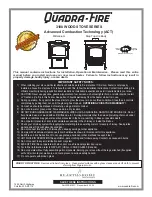
Joinery Waste
Dry wood offcuts will burn well, but don’t expect softwood waste to burn as cleanly or for as long as hardwood logs.
Peat
(Not smokeless in the UK. Smokeless in the RoI) Sod turf must be thoroughly dry.
Lignite
(Not smokeless) A natural mineral, between peat and coal. It lights easily and burns well, but produces much ash.
Housecoal or Bitumous coal
(Not smokeless) Makes a lot of tarry smoke and large volumes of flammable gas which makes it difficult to control and risk explosions. Despite its low cost it rarely
represents good value for money
. Never use housecoal.
Anthracite
(Smokeless) A natural hard, shiny form of coal. Slow to light, it can burn for very long periods with great heat. Despite its high price per bag it generally works out to be
one of the cheapest of all fuels. Use the small ‘nuts’ size.
Coke
(Smokeless) Coke is coal from which the smoke has been removed. Sometimes difficult to light, it burns very cleanly.
Briquettes
Compressed blocks of fuel, generally able to burn for long periods and remarkable for their consistency. ‘Homefire’ and ‘Phurnacite’ are smokeless types while other
brands are made from lignite, peat or housecoal.
Petroleum Coke
(Smokeless in the UK, forbidden in smokeless zones in the RoI) Sold as ‘Petcoke’, ‘Longbeach’ and under various proprietary names, is made from oil. Easy to light and
control, its exceptional heat and lack of protective ash mean that it MUST NOT be used unless mixed with another fuel. Grate and liner life will be drastically reduced
when using petroleum coke.
Household Wastes
Some plastics give off toxic fumes when burned and remember that batteries and aerosols explode! The stove is not an incinerator, so only use the recommended fuels
and NEVER use liquid fuels in any form.
Problems?
Problems like those listed here are usually due to some difficulty with the installation, chimney or fuels, so please check back through these instructions carefully. If
necessary seek specialist advice.
Smoke from the chimney
It is quite normal for a little smoke to be emitted from the chimney when the fire is cold, so start the fire using only a very little fuel. When using wood always ensure that
the primary control ❶ is completely closed and adjust the burning rate using the airwash ❷ control. Use only very dry wood or smokeless fuels.
Poor Heat Output
A stove can heat a typical room of about 12mᶟ volume for each kW of output, so a 5kW model can heat up to (12 x 5) 63mᶟ, a room of about 5m square. The actual size
depends on the insulation and air-change ratio of the room. To attempt to heat a larger room will result in excessive fuel consumption and damaging overheating.
Lack of Controllability
Wood and some other fuels may burn excessively until the gasses in them have been used up. You can reduce this effect by making sure that the fire is set to ‘low’ for a
while before refuelling and checking that the door seals fully.
Condensation
Condensation onto cool surfaces inside the stove can be severe if fuel is in any way damp, use only very dry fuel.
Over-Firing
It is possible to leave the fire too long with the controls set too high leading to ‘over-firing’ seen as glowing metal parts, excessive chimney temperature and risk of parts
failing or chimney fires. Always set controls to the lowest practical setting. A chimney thermometer, from your local stove shop, can help.
Smoke Coming Into Room
Fumes are poisonous – smoke emission must never be tolerated, causes might be:
New stove: There is often a smell and sometimes visible fumes as the paint cures. This normally stops after an hour or so and we advise that you open a
window when firing up a new stove for the first time.
Inadequate seals: Are all flue pipes and connectors absolutely gas tight? Even the tiniest crack or gap can spoil the draught. Does an inset appliance fully seal
against the fireplace?
Blocked throat plate: Has soot or ash collected on the throat plate above the inner back part of the firebox?
Unsuitable, blocked or un-swept chimney: The first requirement for correct operation is a sound chimney. Check the requirements earlier in this document
and in case of any doubt engage a professional sweep or chimney engineer.
Poor air supply: Lack of air to the fire is a common cause of smoking and poor performance. Air supply problems may be worse in certain wind conditions
(often incorrectly ascribed to ‘downdraft’ which is in fact very rare), where air can be sucked out of the room. The answer is to fit an air vent, as near to the fire
as possible, facing into the usual wind direction.
Downdraught: Wind can blow down a chimney if there is something higher nearby such as a tree, hill or high building. Fitting an anti-downdraught cowl to the
chimney top can cure this. Types which cannot be swept through are not recommended.
Poor chimney draught: Chimney draught in use MUST be at least 12Pa.
Chimney Fire
In the rare event of deposits inside the chimney igniting (roaring sound + dense smoke and sparks from the chimney) immediately close the door, shut all air controls,
evacuate the premises and call the fire brigade. Prevent fires by using very dry fuel and having your chimney swept regularly.
Maintenance
Monthly: Check that the flue is clear and unblocked, and
that the door seals are sound.
Annually: Sweep the chimney, the entire length of the
chimney from stove to outlet should be swept.
New Parts: Your stove has been extensively tested for
safety – please don’t try to modify it and always obtain
genuine spare parts from your stove shop or the
manufacturer.
Surface Finish: Wipe the stove body with a slightly damp
cloth when cool. Never use aerosol spray or wax near the
hot fire – they can ignite. Painted steel parts can be
refurbished using special stove spray paint.
Your stove generates very high temperatures; eventually
the internal parts will require replacement.
The Meg stove designs are registered at the UK patent office and protected by Copyright © and UK Design Right. Certain parts are UK Patent Applied For. This document issued 29/04/2013. We are always striving to improve
these products and may change their specification without notice.
Designed and hand built in England
Meg Stoves
Station Works
Hooton Road
Hooton
CH66 7NF
www.megstoves.com
info@megstoves.com
+44(0)151 328 0191






















